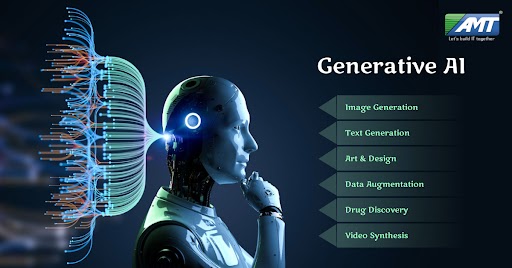Generative AI, short for Generative Artificial Intelligence, refers to a class of machine learning models and algorithms that are designed to create or generate new content. Unlike traditional AI models that are primarily used for classification or prediction tasks, generative AI focuses on the creative aspect of AI by generating new data that resembles the patterns in the training data it was exposed to.
One of the most notable and widely used techniques in generative AI is Generative Adversarial Networks (GANs). GANs consist of two neural networks, the generator, and the discriminator, which are trained together in a competitive setting. The generator tries to produce synthetic data (e.g., images, text, audio) that resembles the real data it was trained on, while the discriminator tries to distinguish between real and fake data. Through this adversarial process, the generator improves over time, becoming more proficient at generating realistic content.
Generative AI has numerous applications across various domains:
- Image Generation: GANs are widely used to generate realistic images, such as photorealistic images of faces, landscapes, or objects.
- Text Generation: Language models like GPT-3 can be used for text generation tasks, including creative writing, content generation, and even code generation.
- Art and Design: Generative AI is used to create novel pieces of art, music, and designs.
- Data Augmentation: Generative models can help create additional training data for machine learning models, especially in scenarios where real data is scarce.
- Drug Discovery: Generative models are utilized in drug discovery to propose new molecules with desired properties.
- Video Synthesis: Advanced generative models can synthesize realistic video sequences from still images or even generate deepfakes.
However, generative AI also raises some ethical concerns, such as the potential for creating misleading content, spreading misinformation, and invading privacy.
As the field of AI continues to advance, generative models are expected to play a more significant role in various industries, enhancing creativity and aiding in tasks that require generating new content. Nonetheless, it’s essential to develop responsible AI practices to mitigate potential risks and ensure these technologies are used for the benefit of society.
- Variational Autoencoders (VAEs): VAEs are another popular approach to generative AI. They are neural networks that can encode and decode data, often used for image and video generation. VAEs learn a probabilistic mapping of the input data into a lower-dimensional latent space. By sampling from this latent space, VAEs can generate new data points.
- Autoregressive Models: Autoregressive models are another class of generative models. They generate data by modeling the probability distribution of each element in the data, conditioned on previous elements. Examples include PixelRNN and PixelCNN for image generation.
- Reinforcement Learning for Generation: Some generative models use reinforcement learning to improve their generation process. In this case, an agent learns to generate data by receiving rewards or penalties based on how well its generated samples match the target data.
- Conditional Generation: Generative models can be conditioned on specific information to generate data that meets certain criteria. For example, conditional GANs can generate images of a specific class or with particular attributes.
- Style Transfer: Style transfer techniques use generative models to combine the content of one image with the style of another. This can be used for artistic effects and image editing.
- Transfer Learning: Pre-trained generative models can be fine-tuned on specific tasks with limited data, enabling faster and more efficient training.
- Uncertainty and Novelty Generation: Generative models can be used to assess uncertainty in predictions and generate novel examples to test the robustness of a model.
- Multi-modal Generation: Some advanced generative models can generate data across multiple modalities, such as generating both an image and a corresponding textual description.
- Domain Translation: Models like CycleGAN can learn to translate data between different domains (e.g., turning images of horses into zebras) without paired training data.
- Super-Resolution: Generative models can be used to upscale low-resolution images, creating higher-quality versions of the input.
Generative AI has made significant strides in the fields of art, design, entertainment, and creative industries. For instance, AI-generated artwork has been showcased in galleries, AI-generated music has been used in compositions, and AI-generated stories have been written in different styles.
Above is in depth information about Generative AI. Watch this space for more updates on the latest trends in Technology
